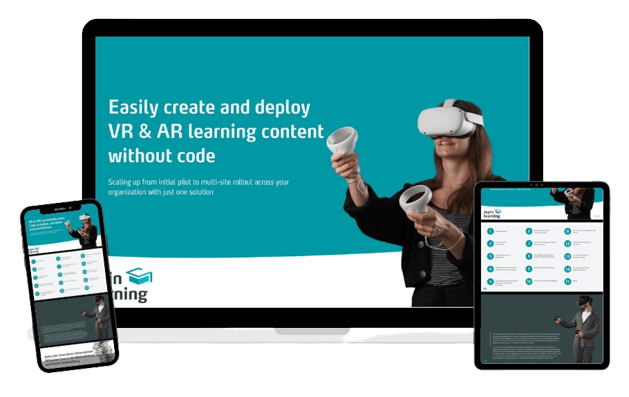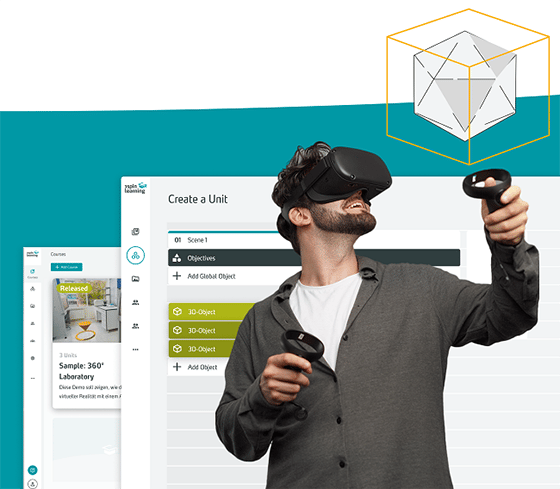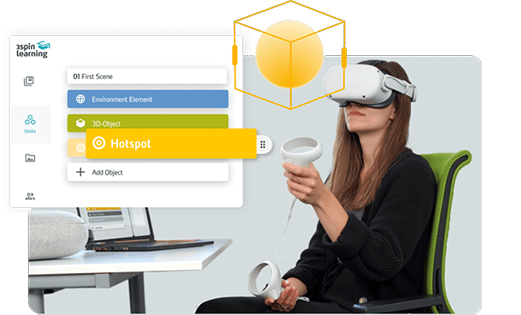Interactive In-Depth Training Thanks To Virtual Reality
Discover how interactive training transforms your employee training by providing an engaging experience that improves engagement, retention and...
Looking to maximize your training potential? Discover how VR training provides a safe, engaging, and effective learning experience
Are you looking for a more effective and engaging way to train your employees or learn new skills? Look no further than immersive VR training. Discover how you can maximize your training potential with Virtual Reality course.
Virtual Reality technology has come a long way since its inception, and it's now being used for much more than just gaming. VR technology has started to make waves in the field of education and training, offering a new way to learn and experience things.
As an innovative method, VR training uses virtual reality technology to create an immersive and engaging environment for learners. In this article, we'll discuss how you can maximize your training potential with immersive training and get started now.
VR training uses Virtual Reality to simulate real-world scenarios for learners to experience. The training modules use computer-generated environments that mimic the real world to train learners in various skills.
VR courses can be used for a range of purposes, from teaching complex concepts in a fun and interactive way to training employees in dangerous or hazardous environments. VR training is often used to help learners develop hands-on skills in a safe and controlled environment.
There are several benefits of Virtual Reality training that make it an ideal method for training employees or learners. One of the most significant benefits of VR training is that it allows learners to experience real-world scenarios in a safe and controlled environment. This means that learners can practice and learn new skills without the risk of injury or danger.
VR training also offers a more engaging and interactive experience than traditional training methods. Learners are more likely to retain information when they are actively engaged in the learning process. Additionally, VR courses offers a more cost-effective method of training employees. With VR training, businesses can save on the cost of materials, travel expenses, and other associated costs.

While VR training has many benefits, there are also some cons to consider. One of the biggest drawbacks of VR training is the cost. VR technology is expensive, and the cost of creating a VR training module can be high.
Additionally, VR training may not be suitable for all learners. Some learners may experience motion sickness or other side effects when using VR technology.
Incidentally, VR authoring platforms including 3spin Learning help you create your own VR training without programming a line of code.
VR courses can be used for a range of purposes, from teaching complex concepts in a fun and interactive way to training employees in dangerous or hazardous environments. Here are some of the different VR training use cases:

VR training should offer realistic scenarios that mimic real-life situations, enabling learners to practice skills and decision-making in a safe environment. This feature ensures that learners get as close to real-life experiences as possible.
VR courses should offer interactivity, allowing learners to engage with the environment, objects, and scenarios in a hands-on way. This feature creates a more immersive and engaging learning experience that can lead to better learning outcomes.
Virtual Reality training should offer customization options, allowing trainers to tailor the training experience to meet specific learning objectives or the needs of the learners. This feature helps to ensure that the training is effective and relevant to the learners.
VR training should provide feedback and assessment to learners, allowing them to track their progress and identify areas for improvement. This feature helps learners to understand their strengths and weaknesses and encourages them to continue practicing and learning.
VR training should support multiple users, allowing learners to collaborate and interact with each other in the virtual environment. This feature enables learners to practice teamwork and communication skills, which are critical in many training scenarios.
The cost of VR training can vary depending on the complexity of the training module and the technology used. A basic VR courses module can cost anywhere from $5,000 to $15,000, while a more advanced module can cost upwards of $50,000.
However, the cost of VR training can be offset by the savings in other areas, such as travel expenses and materials.
Similarly, creating customized VR content such as developing 3D models, animations and interactive simulations can increase the cost of virtual reality training.
When it comes to choosing the right VR training software, there are several factors to consider.
Here are some key things to look for:
In conclusion, implementing VR training in your company would require a combination of hardware, software, and other devices. A suitable VR headset, a powerful computer, VR software, development tools, tracking devices, audio devices, and dedicated physical space are all essential components to consider when implementing VR training. It is essential to consult with VR training experts to determine the best components that would meet your training needs and budget.
Authoring platforms such as 3spin Learning provide companies with a tool to create VR training modules that can be easily customized, modified, and scaled to meet their specific training needs. These platforms offer a wide range of features and tools that enable trainers to create engaging and immersive VR training experiences quickly and efficiently.
and ensure that employees are receiving consistent and effective training. Additionally, authoring platforms allow for easy updates and modifications to training modules, ensuring that the content remains up-to-date and relevant. This scalability and efficiency can lead to faster training times, increased employee proficiency, and ultimately better business outcomes.
If you're looking to maximize your training potential, consider incorporating immersive VR training into your training program.
With its ability to provide realistic scenarios, interactivity, customization options, feedback and assessment, and multi-user support, VR training can offer a highly effective and engaging learning experience that can take your training to the next level.

Discover how interactive training transforms your employee training by providing an engaging experience that improves engagement, retention and...
Discover our new template category for VR training and optimise your training process. User-friendly, efficient and flexible!
Discover the best soft skills courses and further training. Train key skills for work and everyday life now.
Stay up to date on new insights in VR / AR learning with AI and build or improve your knowledge within the technology.